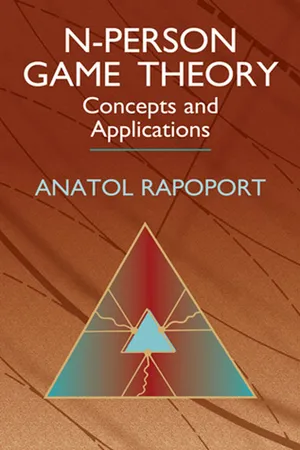![]() PART I. Basic Concepts
PART I. Basic Concepts![]()
1. Levels of Game-theoretic Analysis
The origins of game theory stem from concerns related to rational decisions in situations involving conflicts of interest. The term game theory itself derives from the analysis of so-called games of strategy such as Chess, Bridge, etc. Serious research in this area was doubtlessly stimulated by a need to bring to bear the power of rigorous analysis on problems faced by persons in the culturally dominant roles of “decision makers.” That connections between games of strategy and strategic conflict already exist in the minds of men of affairs appears in the metaphors linking the languages of business, international relations, and war; in short, spheres of activity where strategic shrewdness is assumed to be an important component of competence.
Thus it is easy to portray game theory as an extension of a theory of rational decisions involving calculated risks to one involving calculations of strategies to be used against rational opponents, competitors, or enemies; that is, actors who are also performing strategic calculations with the aim of pursuing their goals and, typically, attempting to frustrate ours.
In short, the game metaphor (business is a game, life is a game, politics is a game) is already firmly established among people whose careers depend on the choice of right decisions and among those who have an appreciation of this process. Consequently, the above mentioned definition of game theory is easily related to what people already know, understand, and appreciate.
Unfortunately, inferences likely to be made from the definition easily lead to a misconception about the scope and the uses of game theory. The widespread appreciation of the decision maker’s role makes it easy to put oneself into his shoes. If I were a decision maker (one might, perhaps, ask oneself), what would I expect from a theory which purports to deal with rational decisions in conflict situations? Clearly, I would expect from such a theory some indications of how rational decisions are to be singled out from all the available ones. Certain features of rational decisions follow from common sense considerations. One must know the range of the possible outcomes which can result as consequences of one’s own choices and also of choices made by others, as well as, perhaps, certain chance events. Having made a list of these outcomes, one must know one’s own order of preference among them and, as appears after a moment of reflection, also the orders of preference of other decision makers, who also exercise partial control over the outcomes by their own choices. Next, one must distinguish between immediate, intermediate, and final outcomes of decisions. Often it is difficult to decide what the preferences are (even one’s own) with regard to the immediate and intermediate outcomes. For these can be evaluated only with reference to the final outcomes, to which they eventually lead, via additional choices of all concerned; and the relation between the former and latter is often not clear.
Anyone who has reflected on problems of decision making in conflict situations will usually quickly grasp the significance of these issues. Namely, these issues must be faced if game theory is to be a useful tool in the search for rational decisions. At this point, the game theorist who has undertaken to explain what he is about faces the difficult task of shifting attention away from these issues, which are not the central ones in game theory, toward other much more fundamental issues. He will have to explain the difference between the theory of some specific conflict situation and a general theory of such situations.
Let us first see what might be the shape of a theory of a specific, strictly formalized conflict situation, say a game of Chess. In Chess, the immediate outcomes of choices are “positions,” i.e., the dispositions of the pieces on the board. These positions are controlled partially by one player, partially by the other, specifically, by the choices which the players make alternately. The positions must be evaluated only with reference to the bearing they have on the final outcome of the game; that is, on whether the outcome is a win for White, a draw, or a win for Black. The preference order of the players among these outcomes is clear. White prefers them in the order named; Black prefers them in the opposite order. Thus the only real problem the chess player faces is that of estimating the bearing which the immediate and the intermediate situations (the “positions”) have on the final outcome.
Indeed, the theory of Chess deals entirely with this problem. In the theory of Chess, certain frequently occurring situations are analyzed with a view of deciding to which of the three possible final outcomes they are likely to lead. Sometimes analysis yields a definitive answer. It is known, for example, that if all the pieces have been captured except one rook, then the possessor of the rook must win the game provided he guides his choices by certain specified rules. Definitive prognoses can be made also in other more complex “end game” situations (i.e., when only a few pieces and pawns remain). Prognoses on the basis of situations arising in the beginning or the middle of the game are, as a rule, not definitive. But this is because the analysis of such situations is too complex to allow the investigation of all possible lines of play. Nevertheless, some prognoses can be made with considerable confidence on the basis of several centuries of experience. Other prognoses are noncommittal except to the extent of assertions like “White (or Black) has a better position.” These too are based on intuitive judgments derived from experience of able players.
Chess theory is, then, essentially concerned with the search for “effective strategies,” i.e., with the search for choices which are “likely” to lead to definitely winning positions or to prevent the opponent from achieving them. It is important to note that “likely” in this insta...
